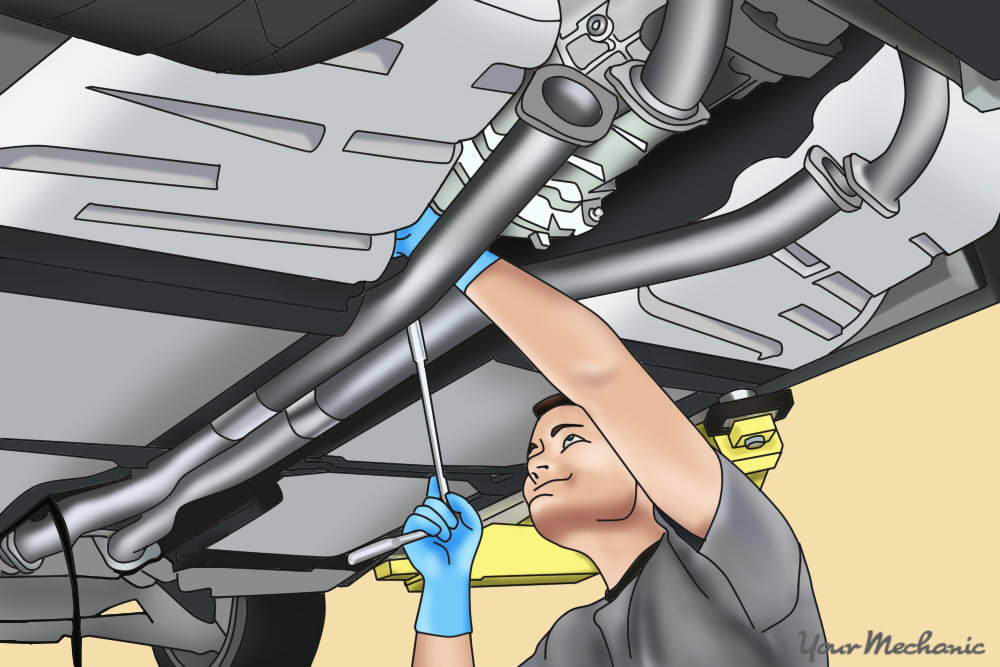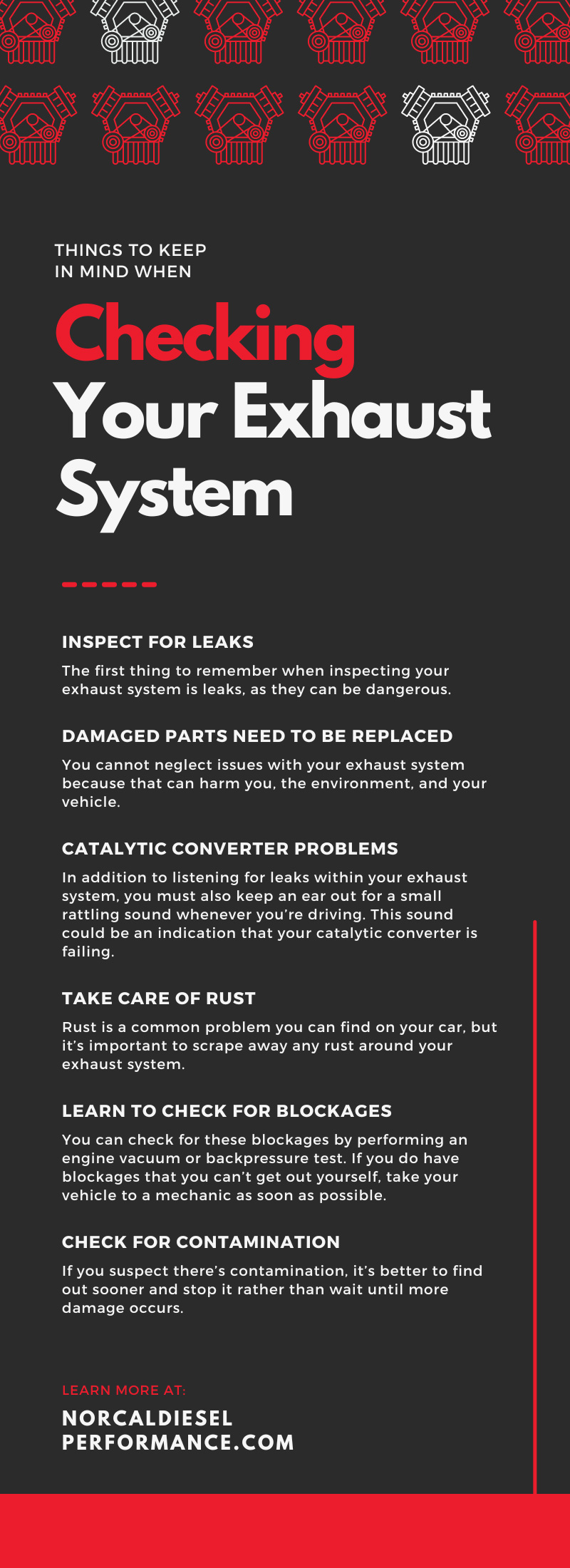How to Check Exhaust System
To check the exhaust system, visually inspect the pipes, muffler, and catalytic converter for any signs of damage or rust. Look for leaks or loose connections, and listen for abnormal noises during engine operation.
Additionally, check for strong exhaust smells, which may indicate a problem. Proper maintenance of the exhaust system is essential to ensure the vehicle’s optimal performance and reduce harmful emissions. Your vehicle’s exhaust system plays a crucial role in directing harmful emissions away from the engine and reducing noise.
Regular inspection and maintenance of the exhaust system are essential to ensure its efficient performance and compliance with environmental regulations. By understanding how to check the exhaust system, vehicle owners can take proactive measures to address potential issues and maintain a safe and environmentally friendly driving experience. We will explore the key steps to effectively check and maintain the exhaust system, promoting vehicle longevity and environmental responsibility.

Credit: www.galpinvolkswagen.com
Importance Of Exhaust System Maintenance
Maintaining your vehicle’s exhaust system is crucial for ensuring proper vehicle operation and preventing harmful emissions. The exhaust system serves multiple functions that are essential for your car’s performance and the environment. By regularly checking and maintaining your exhaust system, you can ensure that your vehicle operates smoothly, minimize the risk of breakdowns, and reduce the impact of harmful emissions on the atmosphere.
Ensuring Proper Vehicle Operation
A properly functioning exhaust system plays a vital role in ensuring the overall performance of your vehicle. It helps to safely and efficiently remove the harmful gases produced during the combustion process, allowing your engine to operate at its optimum level. A clogged or damaged exhaust system can restrict the flow of exhaust gases, leading to poor engine performance, reduced power, and decreased fuel efficiency. By regularly checking your exhaust system, you can identify any issues early on and address them promptly to keep your vehicle running smoothly.
Preventing Harmful Emissions
Your vehicle’s exhaust system is responsible for reducing the emissions of harmful gases, such as carbon monoxide, nitrogen oxide, and hydrocarbons, into the atmosphere. These gases can contribute to air pollution and have detrimental effects on human health and the environment. Regular maintenance of your exhaust system can help prevent leaks, cracks, and other issues that could result in the release of these harmful emissions. By keeping your exhaust system in good condition, you are doing your part to protect the environment and ensure cleaner air quality for everyone.

Credit: www.yourmechanic.com
Signs Of Exhaust System Issues
Identifying potential problems with your exhaust system is crucial for maintaining the optimal performance of your vehicle and ensuring the safety of all passengers. Understanding the signs of exhaust system issues can help you address any problems early, preventing further damage to your vehicle.
Unusual Noises
One of the primary indicators of exhaust system issues is unusual noises emanating from your vehicle. If you notice loud rattling, hissing, or popping sounds coming from the exhaust system, it may be a sign of a leak or damaged components. Such noises can indicate a failure in the exhaust manifold, gasket, or muffler, requiring immediate attention to prevent further damage.
Decreased Fuel Efficiency
A decline in fuel efficiency can be another sign of exhaust system problems. When your exhaust system is compromised, it can affect the engine’s performance, leading to inefficient fuel combustion. If you find yourself visiting the gas station more frequently despite your driving habits remaining consistent, there may be an underlying issue in the exhaust system that needs to be addressed to restore optimal fuel efficiency.
Steps To Check The Exhaust System
The exhaust system of a vehicle is a crucial component that ensures the safe and efficient operation of the vehicle. Regular inspection of the exhaust system is essential to prevent potential problems that could lead to hazardous situations. Here are the basic steps to check the exhaust system and identify any issues.
Visual Inspection
A visual inspection of the exhaust system involves looking for any visible damage or corrosion on the pipes, muffler, and exhaust manifold. Check for any loose or broken hangers that support the exhaust system. Ensure that all components are securely fastened and in good condition.
Listening For Abnormal Sounds
Listen for any abnormal sounds such as rattling, hissing, or loud exhaust noise when the vehicle is running. These sounds can indicate potential issues with the exhaust system, such as loose or damaged components, and should be investigated further.
Checking For Leaks
Inspect the exhaust system for any signs of leaks, such as black soot around the joints or a strong smell of exhaust fumes inside or outside the vehicle. Leaks can affect the performance of the exhaust system and pose a danger due to exposure to harmful gases.
Testing Catalytic Converter
Check the catalytic converter for any signs of damage or malfunction. This component plays a vital role in reducing harmful emissions, so it must be functioning correctly. Look for any warning lights on the dashboard that indicate potential issues with the catalytic converter.
Examining O2 Sensors
Inspect the O2 sensors for any visible damage or signs of wear. These sensors monitor the oxygen levels in the exhaust gases and help regulate the fuel mixture. Faulty O2 sensors can lead to decreased fuel efficiency and increased emissions.
Tools Required For Inspection
When it comes to checking your exhaust system for any issues or potential problems, having the right tools is essential. With the right tools on hand, you can perform a thorough inspection and ensure that your exhaust system is in good condition. Here are the important tools you’ll need:
Flashlight
A flashlight is an essential tool for inspecting your exhaust system. It allows you to see the various components of the system, such as the exhaust pipes, muffler, and catalytic converter, more clearly. With a flashlight in hand, you can examine these components for any signs of damage, corrosion, or leaks.
Jack Stands
Jack stands are necessary for safely lifting your vehicle off the ground. They provide stability and support while allowing you better access to the exhaust system. By using jack stands, you can securely raise your vehicle and inspect the exhaust system without risking your safety.
Safety Gloves
Safety gloves are a crucial tool to have when working on your exhaust system. These gloves protect your hands from sharp edges, heat, and any potentially harmful materials. They provide an extra layer of safety and prevent injuries while inspecting and handling the different components of your exhaust system.
Exhaust Pressure Gauge
An exhaust pressure gauge is a specialized tool used to measure the pressure within the exhaust system. By attaching the gauge to the appropriate port, you can determine if there are any issues with the system’s backpressure. Checking the pressure can help identify problems like a clogged catalytic converter or a blocked exhaust pipe.
Having these tools at your disposal will allow you to conduct a thorough inspection of your exhaust system. Remember, regular maintenance and inspections are vital for keeping your exhaust system in optimal condition and ensuring that your vehicle runs smoothly.
Importance Of Professional Inspection
Importance of Professional Inspection:
Expert Diagnosis
Professionals: understand the exhaust system intricacies.
Accurate: diagnosis crucial for proper repairs.
Timely Repairs
Early detection: Leads to cost-effective solutions.
Prevent: further damage by addressing issues promptly.

Credit: norcaldieselperformance.com
Frequently Asked Questions On How To Check Exhaust System
How Do You Know If Your Exhaust System Is Bad?
Signs of a bad exhaust system include loud noises, decreased fuel efficiency, strong odors, and visible smoke.
How Do You Test An Exhaust?
To test an exhaust, follow these steps: 1. Start the engine and listen for unusual noises. 2. Visually inspect the exhaust for cracks or leaks. 3. Use a handheld diagnostic tool to check for codes or sensor issues. 4. Measure the exhaust emissions with a gas analyzer.
5. Conduct a smoke test to identify any leaks.
How Do I Know If My Exhaust Needs Replacing?
You can tell if your exhaust needs replacing if you notice loud noises, decreased fuel efficiency, rattling, or a rotten smell coming from your car. It’s best to have a professional inspect your exhaust system to determine if a replacement is necessary.
How Do I Know If My Exhaust Pipe Is Clogged?
Check for a decrease in engine performance, loud noise, or a burnt smell. Look for black soot around the exhaust pipe. If you notice these signs, your exhaust pipe may be clogged.
Why Is It Important To Check Exhaust System?
Regular inspection ensures vehicle efficiency and safety, preventing emissions and engine damage.
How Can I Visually Inspect My Exhaust System?
Look for rust, holes, or damaged hangers under the car for potential issues.
What Are Signs Of A Failing Exhaust System?
Listen for loud noises, smell gas fumes, or notice decreased performance.
Conclusion
Regularly checking your exhaust system is crucial for the overall well-being of your vehicle. By following the simple steps outlined in this blog post, you can ensure that your exhaust system remains in optimal condition, contributing to better fuel efficiency, reduced emissions, and enhanced performance.
Remember, a well-maintained exhaust system not only protects the environment but also prolongs the life of your car. So, don’t overlook the importance of this essential maintenance task.
